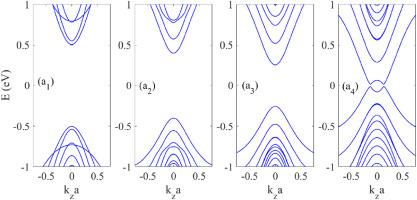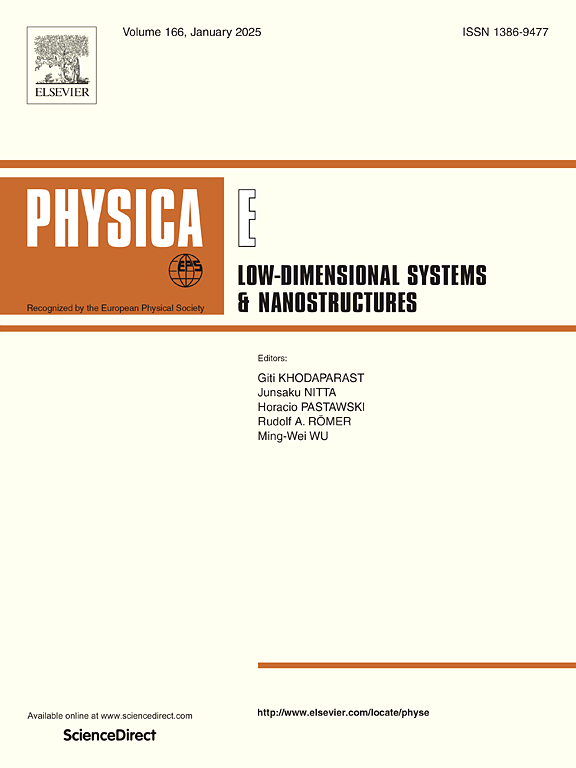电场和磁场下磷化硼纳米管的电子和热特性调制
IF 2.9
3区 物理与天体物理
Q3 NANOSCIENCE & NANOTECHNOLOGY
Physica E-low-dimensional Systems & Nanostructures
Pub Date : 2024-10-10
DOI:10.1016/j.physe.2024.116125
引用次数: 0
摘要
本研究以指数为 (20, 0) 的人字形磷化硼纳米管(BPNT)为研究对象,采用紧结合模型、格林函数法和 Kubo 形式主义对其热电性能进行了理论研究。通过将其带状结构与计算的密度泛函理论带状结构相匹配,获得了紧密结合参数。研究考察了横向电场和轴向磁场对各种物理性质的影响,如带结构、态密度(DOS)、热容量、磁感应强度和其他热电性能。BPNT 始终具有半导体特性,直接带隙接近 1 eV。BPNTs 的电子特性受到外加电场的显著影响,在极强的电场强度下,可诱导从半导体到金属的相变。相反,磁场会导致能带分裂,尤其是在费米级附近。DOS 也会随着电场的变化而变化,包括 DOS 峰的位置、强度和数量的变化。BPNT 的热特性和热电性能与温度有关。激发电子热能的增加会导致传导带中的高能级被更多占据。电场通过改变 BPNTs 的电子特性并减小带隙,进一步增强了其热特性。较强的电场会明显增强 BPNTs 的热性能,因为它会增加激发电荷载流子的浓度。这对于提高 BPNTs 的热电效率至关重要,从而使其在实际应用中更具竞争力。本文章由计算机程序翻译,如有差异,请以英文原文为准。

Modulation of electronic and thermal properties of boron phosphide nanotubes under electric and magnetic fields
This work theoretically investigates the thermoelectric properties of boron phosphide nanotubes (BPNTs) using the tight-binding model, Green function method, and Kubo formalism, focusing on a zigzag BPNT with indices (20, 0). The tight binding parameters obtained by matching its band structure with calculated density functional theory band structure. The study examines the effects of transverse electric fields and axial magnetic fields on various physical properties, such as band structure, density of states (DOS), heat capacity, magnetic susceptibility, and other thermoelectric properties. BPNTs consistently show semiconducting properties with a nearly 1 eV direct band gap. The electronic properties of BPNTs are significantly affected by applied electric field, which at very strong strengths can induce a semiconducting to metallic phase transition. In contrast, the magnetic field leads to the splitting of energy bands, especially around the Fermi level. The DOS also changes with the electric field, including variations in the position, intensity, and number of DOS peaks. The thermal properties and thermoelectric performance of BPNTs are temperature-dependent. Increasing of excited electrons thermal energy cause more occupation of high energy levels in the conduction bands. The electric field further enhances the thermal properties of BPNTs by modifying their electronic properties and reducing the band gap. Stronger electric fields cause a noticeable enhancement in the BPNTs thermal properties because it is increasing the concentration of excited charge carriers. This aspect is crucial for improving the thermoelectric efficiency of BPNTs, making them more competitive for practical applications.
求助全文
通过发布文献求助,成功后即可免费获取论文全文。
去求助
来源期刊
CiteScore
7.30
自引率
6.10%
发文量
356
审稿时长
65 days
期刊介绍:
Physica E: Low-dimensional systems and nanostructures contains papers and invited review articles on the fundamental and applied aspects of physics in low-dimensional electron systems, in semiconductor heterostructures, oxide interfaces, quantum wells and superlattices, quantum wires and dots, novel quantum states of matter such as topological insulators, and Weyl semimetals.
Both theoretical and experimental contributions are invited. Topics suitable for publication in this journal include spin related phenomena, optical and transport properties, many-body effects, integer and fractional quantum Hall effects, quantum spin Hall effect, single electron effects and devices, Majorana fermions, and other novel phenomena.
Keywords:
• topological insulators/superconductors, majorana fermions, Wyel semimetals;
• quantum and neuromorphic computing/quantum information physics and devices based on low dimensional systems;
• layered superconductivity, low dimensional systems with superconducting proximity effect;
• 2D materials such as transition metal dichalcogenides;
• oxide heterostructures including ZnO, SrTiO3 etc;
• carbon nanostructures (graphene, carbon nanotubes, diamond NV center, etc.)
• quantum wells and superlattices;
• quantum Hall effect, quantum spin Hall effect, quantum anomalous Hall effect;
• optical- and phonons-related phenomena;
• magnetic-semiconductor structures;
• charge/spin-, magnon-, skyrmion-, Cooper pair- and majorana fermion- transport and tunneling;
• ultra-fast nonlinear optical phenomena;
• novel devices and applications (such as high performance sensor, solar cell, etc);
• novel growth and fabrication techniques for nanostructures

 求助内容:
求助内容: 应助结果提醒方式:
应助结果提醒方式:


